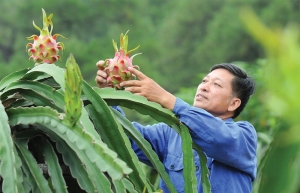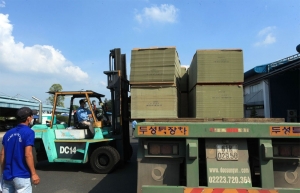Chinese tourism set to influence Vietnam’s targets
Tu Quy Thanh, head of Lien Bang Travel, believes that Vietnam will be able to accommodate the flow of tourists from China after the first quarter.
“Visitor numbers from China have cannot yet bounce back during this festive season as flights restart, because some of China’s new regulations do not yet affect its biggest cities, and flight frequency is still limited,” Thanh said.
 |
| On the top of a local mountain is a statue of Quan Am Buddha, while at the foot of the mountain the Ngo Dong River bends and takes visitors under three natural mountain caves. (Photo: VNA) |
As of January 8, the China National Health Commission is set to abolish required quarantine for travellers entering the country. This action is seen as the next stage in China’s plan to progressively relax its strict pandemic policy, which it has maintained for over three years.
In research issued in December 2022, Michael Kokalari, chief economist at VinaCapital Fund Management, said that the most significant effect on Vietnam is that the number of visitors would likely bounce back in the second half of the year. “We anticipate the reopening of China will increase Vietnam’s GDP growth by more than 2 per cent this year if Chinese visitors return in the second half of 2023,” Kokalari added.
According to VinaCapital, international tourism contributed around 10 per cent of Vietnam’s GDP before the pandemic, and the number of foreign visitors is on course to reach 25 per cent of pre-pandemic levels in 2023. The number of foreign visitors predicted to travel to Vietnam will reach over 50 per cent of pre-2019 levels by 2024, based on the premise that Chinese tourist arrivals will revert to normal in the second half of this year.
The loosening of pandemic prevention regulations has long been foreseen, but China’s rapid shift in policy has also left many Vietnamese tourism groups worried. One issue is psychological, with many enterprises still concerned about safety when Chinese visitors travel to Vietnam, given that the number of cases and deaths in the northern neighbour is reportedly still high.
Another obstacle comes from Chinese service providers, as only when the Chinese government formally opens will the tourist service supply chain resume full operations. To ensure tour safety, travel companies require time to prepare services and plan departures.
However, the news of China’s reopening shift still gives optimism to the tourist sector, laying the foundation for Vietnam to accomplish its aim of hosting eight million foreign visitors in 2023. According to a report by the Institute for Tourism Development Research, Chinese tourists previously accounted for as much as 30 per cent of the total number of foreign visitors to Vietnam. The primary destinations for Chinese visitors were Khanh Hoa, Quang Ninh, Danang, Phu Quoc, Hanoi, and Ho Chi Minh City.
Tran Khanh Hien, analyst director at VNDirect Securities Corporation, also estimates that the proportion of Chinese tourists of the overall number of overseas visitors to Vietnam in 2019 was around 30 per cent.
“Therefore, with the scenario of China gradually easing restrictions in the second quarter of 2023, the number of tourists coming to Vietnam from the United States, the EU, Japan, South Korea, and Southeast Asia in general is anticipated to see a rebound,” Hien said.
 | Chinese activity back in vogue as fruit and veg surge As of January 8, Chinese customs will no longer tests imported commodities, including frozen foods, for COVID-19 at the border – action demonstrating that the Chinese government has taken another step towards complete reopening after its National Health Commission stated last month that it would soften its pandemic response. |
 | Trade possibilities restored as China softens restrictions It is anticipated that reopening of China’s border could somewhat alleviate Vietnam’s sluggish import and export positions. |
What the stars mean:
★ Poor ★ ★ Promising ★★★ Good ★★★★ Very good ★★★★★ Exceptional
Related Contents
Latest News
More News
- Double-digit GDP growth within reach with shift to higher-value expansion (January 06, 2026 | 08:33)
- Takeda Vietnam awarded for ongoing support of Vietnam’s sustainability efforts (December 31, 2025 | 21:00)
- Vietnam's retail market tops $269 billion in 2025 amid e-commerce boom (December 31, 2025 | 19:00)
- Stronger legal framework urged as trade fraud surges online (December 31, 2025 | 18:58)
- FPT exports first chip shipment to Japan (December 31, 2025 | 10:47)
- AkzoNobel rolls out sustainability campaign “It All Adds Up” for the wood sector (December 31, 2025 | 09:23)
- Textile apparel firms deliver robust earnings despite global tariff pressures (December 30, 2025 | 10:09)
- Businesses ramp up production as year-end orders surge (December 30, 2025 | 10:05)
- Vietjet chairwoman awarded Labour Hero title (December 29, 2025 | 13:06)
- How to unlock ESG value through green innovation (December 29, 2025 | 10:03)

 Tag:
Tag:

















 Mobile Version
Mobile Version